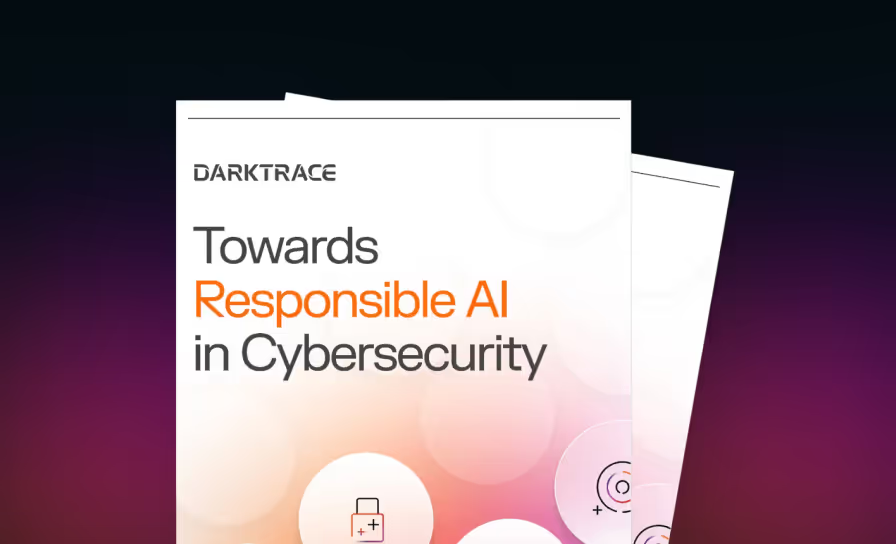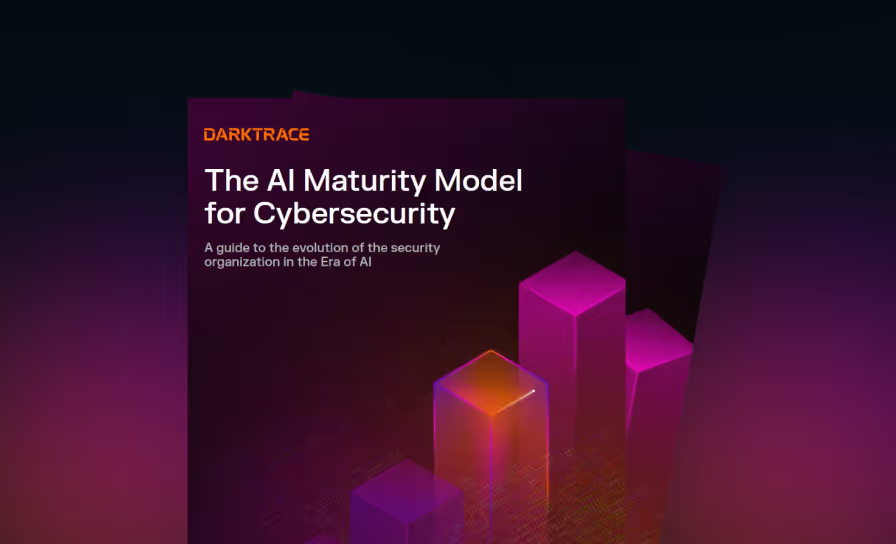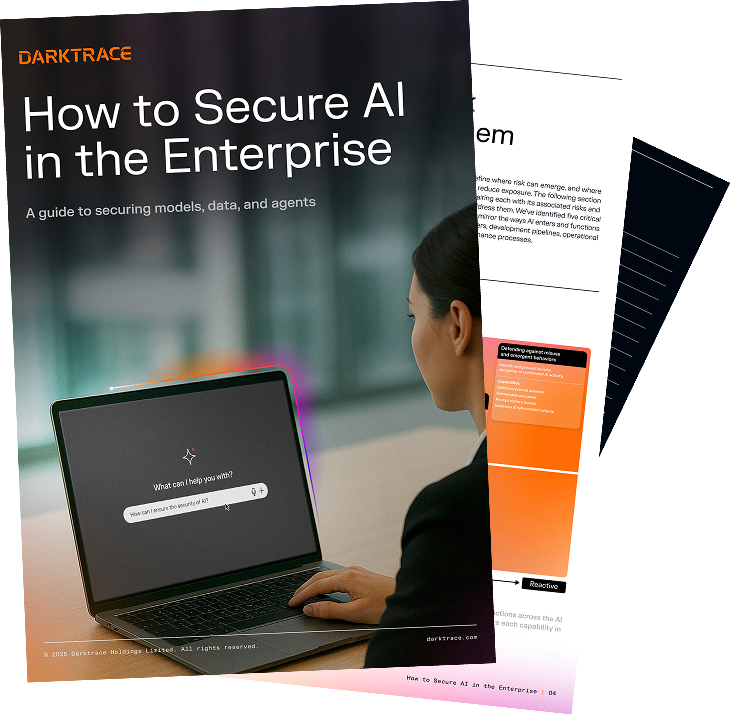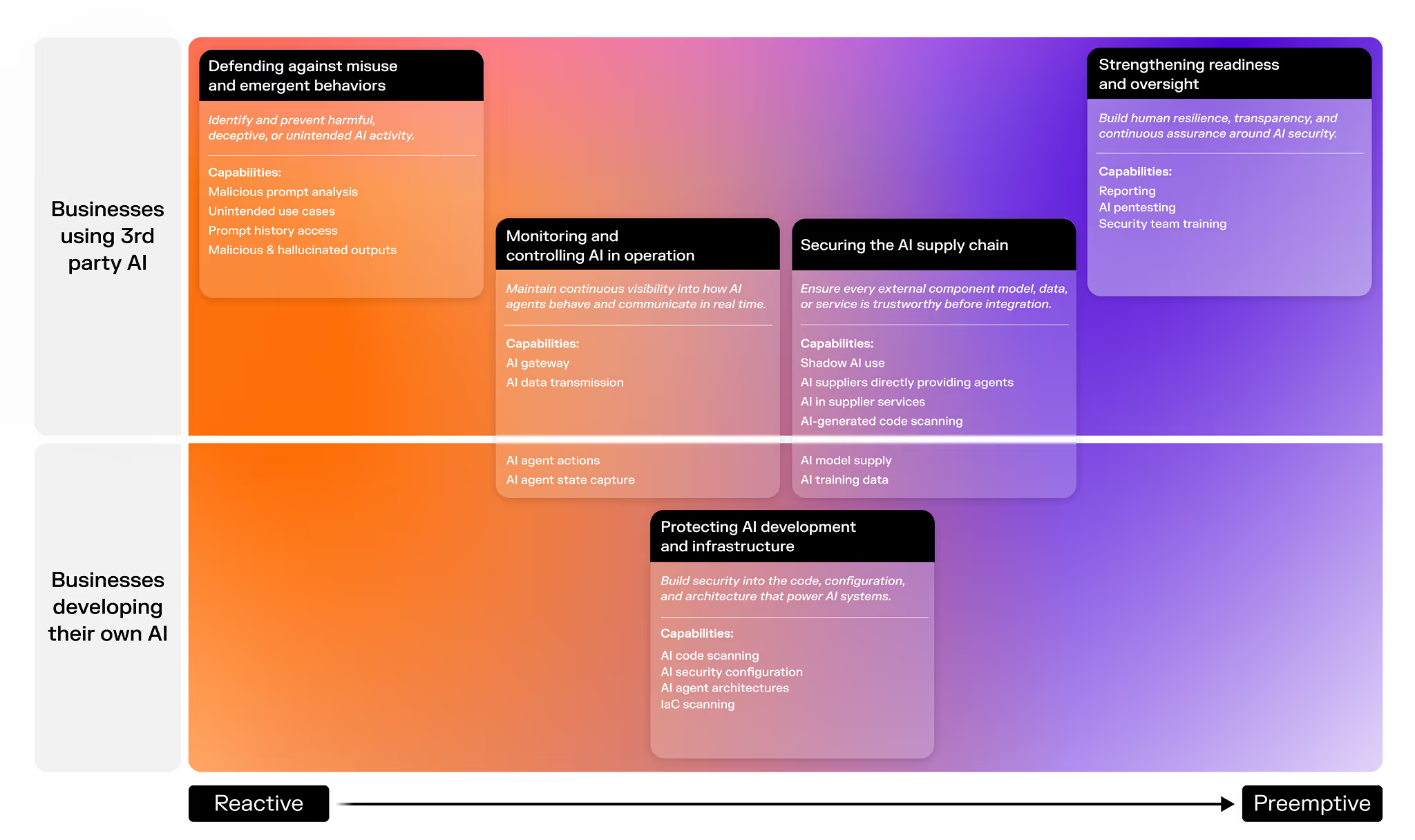Securing AI in the Enterprise
AI is accelerating faster than governance can keep up, expanding attack surfaces and creating unseen risks. From data and models to AI agents and integrations, security starts by knowing what to protect.

Five categories for
securing AI
AI introduces risk through both third-party tools and internally developed systems. This framework shows how those risks span five categories, from preemptive controls in AI development to reactive measures in live operations, helping security leaders visualize where protection is needed across the enterprise.
AI adoption rapidly expands the attack surface
Autonomous and generative AI agents
Systems capable of independent action can operate beyond human guardrails or monitoring.
Embedded AI in SaaS and productivity tools
Employees use AI features that process sensitive data outside direct security visibility.
Cloud and on-prem providers extending services with AI
New embedded functions increase complexity and expand the perimeter of control.
Vendors and acquired software adding AI features
Third-party tools introduce AI capabilities without clear oversight or risk evaluation.
Security leaders must uncover where AI lives in their organization
AI manifests in various ways: employee productivity tools, cloud services, vendor solutions, and internally developed systems. Without a clear inventory of where and how AI is being used, organizations face blind spots that can undermine even the most robust security strategies.
Map where employees interact with AI tools, both approved and unapproved. Discovery efforts should include sanctioned tools as well as shadow AI use across departments.
Review cloud providers, on-prem systems, and vendor solutions for embedded AI capabilities. Understanding which suppliers use AI, and how they use your data, is critical for visibility and contractual assurance.
Engage development teams to map how internal models are created and maintained, building the visibility required for strong governance.

Identifying AI risks is essential for effective governance and security
Every AI system brings its own set of uncertainties, ranging from data leakage and model bias to regulatory exposure. Recognizing these risks is the first step toward building AI governance frameworks that ensure AI operates safely, transparently, and in alignment with business objectives.

Deepen your understanding of AI-driven cybersecurity
AI is reshaping how organizations defend, detect, and govern. These resources offer expert insights, from evaluating AI tools and building responsible governance to understanding your organization’s maturity and readiness. Discover practical frameworks and forward-looking research to help your business innovate securely.

Build trust through transparency and responsible innovation
How do you balance innovation with governance and security? Explore the principles guiding ethical, explainable AI in cyber.

Discover the spectrum of AI types in cybersecurity
Understand the tools behind modern resilience, from supervised machine learning to NLP, and how they work together to stop emerging threats.

Benchmark your AI adoption against the industry in cyber
The AI Maturity Model helps CISOs and security teams assess current capabilities and chart a roadmap toward autonomous, resilient security operations.

Make informed decisions when investing in AI security tools
Cut through the hype. Learn what to ask vendors, how to evaluate AI models, and what criteria ensure accuracy, transparency, and trust in your next cybersecurity investment.
Get the full guide
Discover how to identify AI-driven risks, so you can establish governance frameworks and controls that secure innovation without exposing the enterprise to new attack surfaces.

Download now
FAQs
Identifying AI security risks involves understanding how AI systems interact with data, users, and connected technologies. Continuous AI monitoring across models, prompts, and integrations helps reveal anomalies or unintended behavior. Combined with AI security posture management, this provides a clear picture of system integrity as AI environments evolve.
AI governance and AI risk management frameworks define how AI is controlled, audited, and aligned with organizational and regulatory expectations. Standards such as the NIST AI Risk Management Framework (RMF) and ISO/IEC 42001 emphasize transparency, accountability, and consistency, ensuring that AI systems are managed responsibly across their lifecycle.
Responsible AI refers to the secure and ethical use of AI technologies in alignment with established governance and regulatory principles. In cybersecurity, it focuses on ensuring transparency, traceability, and trust so that AI-driven decisions and actions can be understood, validated, and safely integrated into enterprise systems.
AI monitoring encompasses the continuous observation of model behavior, data flows, and system outputs to identify unexpected or unauthorized activity. It provides ongoing visibility into how AI operates within its environment, helping maintain confidence in accuracy, security, and compliance over time.
AI security posture management (AI-SPM) is the process of maintaining and evaluating the configuration, policy, and control environment of AI systems. It provides continuous insight into security readiness, allowing teams to detect misconfigurations or emerging risks before they affect broader operations.
AI supply chain security focuses on validating the integrity of external AI components—such as models, datasets, and APIs—that are introduced into an organization. It helps ensure that external sources are legitimate, properly licensed, and free from malicious or manipulated content.
Securing AI systems means addressing risks throughout the AI lifecycle, including model creation, training, deployment, and ongoing operation. This involves protecting data, monitoring system behavior, and maintaining governance structures that preserve trust and reliability.
This is the AI model risk describes the potential for models to produce biased, inaccurate, or harmful outcomes due to poor data quality, design flaws, or manipulation. Managing model risk depends on the reliability of training data, the accuracy of performance metrics, and the transparency of model behavior.efault text value


















